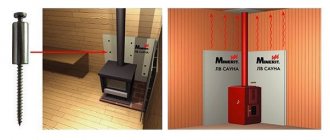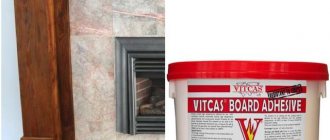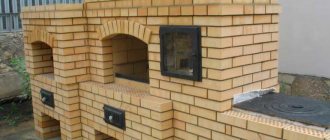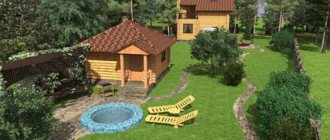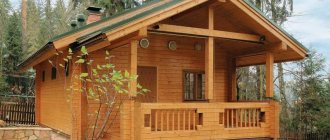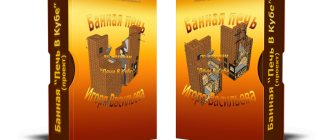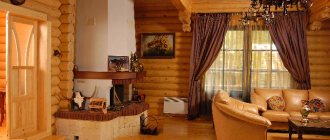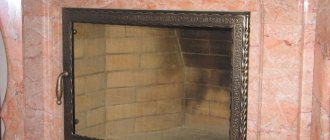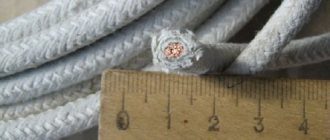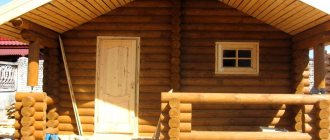Thermal insulation of a furnace is actually a much more important process than it might seem at first glance. Unfortunately, many owners of private houses neglect stove insulation, considering it an unnecessary measure. In this article we will look at the reasons why stoves are insulated and methods of insulation.
Thermal insulation of the stove allows you to protect the walls of the building from the heat of the stove.
Materials for thermal insulation of fireplaces
Special thermal insulation for fireplaces is used to minimize heat loss in all parts of the fireplace: the chimney, the stove mass and the firebox itself. This allows you to increase the efficiency of heating equipment. Insulation of different parts of the fireplace has the following goals:
- Protects the chimney from the destructive effects of condensation that forms during a sudden change in temperature. The aggressive effect of condensate is due to the moisture content, various acids formed during combustion and carbon dioxide.
- Where the pipe passes through the ceiling, special care should be taken to comply with fire safety standards. If wooden building materials are used, special care should be taken to protect the surface of the ceiling.
- High-temperature insulation in fireplaces is used to create a directed flow of thermal energy to warm people sitting across from it. For these purposes, infrared reflectors are used, which are installed in the firebox itself.
- Protection of wall structures using a heat-protective layer. Otherwise, a brick wall can quickly become unusable due to a sharp temperature change, and a wooden wall can catch fire.
The building materials used for thermal insulation of the fireplace are represented by the following groups:
- containing stone fibers (Rockwool, TEXHO T80, PAROC FPS 17) – are produced in the form of slabs and have a foil coating on one of their sides, which allows them to withstand temperatures of several thousand degrees;
- based on silica obtained from quartz sand and alumina, produced in the form of flexible plates;
- Superizol - is made using calcium silicate and has good thermal insulation qualities, suitable for insulating fireplace bodies and their chimneys, attached with glue or self-tapping screws;
- Vermiculite – presented in the form of slabs (Scamol, Thermax), consists of compressed grains of the substance, is rigid, easy to saw, and has a surface suitable for finishing;
- Supersil - is a fabric made of silica with a layer of foil, has a high cost;
- gypsum fiber - obtained by mixing and pressing gypsum and cellulose, suitable only for insulating solid fireplaces, floors and walls, does not withstand loads and is deformed.
When choosing materials, it is important to make sure that they are environmentally safe so that they do not release toxic substances into the environment when heated.
Classification
Non-flammable fire-resistant insulation is often classified according to its state of aggregation, appearance, internal structure, depending on which it can be:
- Frame , including multilayer, reinforced with non-combustible materials, often used as elements of structural fire protection of load-bearing metal structures of construction projects.
- Rolled , which allows you to wrap it around elements of building structures of various shapes and cross-sections, as well as sections of pipelines and ventilation ducts that need to be protected from freezing and possible exposure to fire in the event of a fire.
- Slab , as well as in the form of separate heat-insulating mats, specially developed by designers and manufacturers of standard sizes, which facilitates their installation and installation inside building structures, for example, partitions between rooms.
- Loose , including artificially expanded, cellular, which significantly increases its thermal insulation properties.
- Liquid foaming material that hardens during polymerization and drying after application to building structures, sections of pipeline networks, ventilation systems of protection facilities, most often called fire-resistant foam.
The choice of one or another class of non-combustible, fire-resistant insulation is determined both by design solutions and experience of use in civil and industrial construction during the construction and repair of various objects.
| Slab fire-resistant insulation | Foil fire-resistant insulation for chimneys of stove pipes |
| Stitched foil fire-resistant insulation | Fire resistant mineral wool |
Protective screens for furnaces
The thermal insulation material used for stoves must not only prevent the possibility of fire, but also protect people from too harsh infrared radiation. Protective screens for fireplaces, as well as for sauna stoves, are ideally suited for these purposes. They can be made of metal or using brick or decorative stone.
The peculiarity of fireplace screens is that they are made exclusively of metal and can be built-in or mobile. Such designs prevent sparks and hot coals from entering the room, and also, when heated, contribute to the rapid and uniform heating of the air in the room. You can purchase a protective fence or make it yourself. Let's take a closer look at the features of furnace protective screens.
Brick protective screen
Along with insulation, the furnace is insulated using bricks. There are two options: constructing a protective wall and lining the furnace with bricks. In both cases, the brick is laid using an adhesive mixture or clay. The use of cement mortar is considered as a last resort. When lining the stove with brick, it is necessary to provide a gap of 3 to 10 cm, as well as ventilation holes at the bottom and top to ensure better convection and quick heating of the room.
If you decide to build a protective wall, you should remember that the masonry is half a brick thick (120 mm); the height of the wall should be slightly higher than the stove itself. Thanks to this structure, a uniform and soft heat is created in the bathhouse, which eliminates the need for continuous heating and allows you to steam for several hours.
Application of bricks
One of the old methods of making non-combustible thermal insulation for metal pipes involves the use of broken refractory or clay bricks.
In this case, a steel casing was created around the pipe so that the gap between it and the pipe was about 50-100 mm. The broken brick is poured into this gap. The brick does not need to be compacted and compacted to create thermal gaps. This method of insulation is inexpensive, because it practically does not require special purchase of materials. The disadvantage is the large weight of the entire pipe structure, which negates all other advantages of metal chimneys - quick erection, mobility, the ability to create any configuration.
Stainless steel casing
Thermal insulation of the furnace using stainless steel casing has several options. Based on orientation in space, front and side screens . The recommended distance from the oven to the screen is from 1 to 5 cm . Thanks to such structures, it is possible to reduce the intensity of thermal radiation from a metal furnace, since the outer surface of the protective screens warms up to 1000 C. In this case, it is possible to reduce the distance from the furnace to the wall to half a meter. Ease of installation and the presence of special legs that allow you to securely fasten the screens make their use especially attractive.
Content:
- How to calculate the foundation for a brick stove
- Types of foundation for a stove
- Columnar furnace foundation
- Rubble concrete foundation
- Reinforced concrete slab
- Construction errors and their consequences
- Waterproofing and pouring the foundation for the furnace
- Video on the topic of foundation for a stove
Despite the abundance of appliances that are used for heating houses and apartments, stone stoves do not lose their relevance. Many homeowners install them in new houses and baths. In fact, there is no particular hassle with it, apart from the preparation of firewood, but there are many advantages. But, despite its apparent simplicity, a stone stove is a rather complex heating device and its installation is best left to stove masters.
Basalt with cladding
Basalt facing slabs look aesthetically pleasing and provide good fire protection. In addition, this material gives off heat for a long time after heating. You can use this material to cover both a brick screen and the wall itself on top of insulating sheets.
Fire safety cannot be treated negligently - the consequences of carelessness can be tragic. The modern building materials market allows you to choose an option according to your means and taste, while providing reliable protection against fire.
Main parameters of insulation
Thermal conductivity
When choosing insulation, the main attention is paid to its most important parameter - thermal conductivity , which does not at all depend on the density of the material, as many mistakenly believe. Insulation materials of the same density, but manufactured using different technologies, may have different heat conductivity.
The lower the thermal conductivity coefficient, the more effective and better the selected insulation material retains heat in the house.
Thermal conductivity coefficients of various materials (W/mK)
Water absorption
Another very important characteristic of insulating material is its ability to absorb moisture. Water vapor is always present in the air. Under certain situations, it can turn into condensation inside the insulation, significantly reducing its thermal properties.
In this case, a vapor barrier must be provided. This issue becomes relevant if the loggia is also insulated.
Fire resistance
Insulation, like the entire structure of a house, especially a wooden one, must also have fire-fighting properties. This is especially important for insulating chimneys, fireplaces and other elements of the house that are directly exposed to strong heat or direct contact with fire.
Comparative fire tests
Rubble concrete foundation
In addition to the columnar foundation, the so-called rubble concrete type of foundation is often used for the furnace. To construct it, it is necessary to prepare a foundation pit. Its dimensions should exceed the plan dimensions of the future furnace by 150 mm.
The bottom of the pit is leveled and covered with a layer of broken brick or crushed stone. The backfilled material must be compacted and the surface brought to zero on a horizontal surface. The next step is to assemble the formwork from the boards. It is installed on the finished base and filled with large stones and small crushed stone mass. After this, the resulting layer, and its thickness should be several centimeters, is filled with a mixture of sand and cement. Once the solution has set, you can begin to form the second layer. This work can be stopped when 60 - 70 mm remain to the upper edge of the formwork. The resulting surface is leveled horizontally. After this, the formwork can be covered with polyethylene and left for a week. After this period, you can begin laying the stove.
